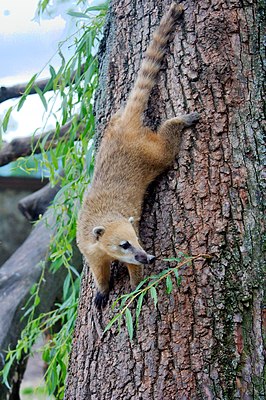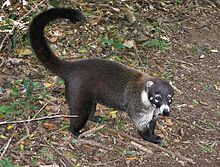Coatis
| Coatis | ||||||||||||
|---|---|---|---|---|---|---|---|---|---|---|---|---|

South American coati ( Nasua nasua ) |
||||||||||||
| Systematics | ||||||||||||
|
||||||||||||
| Scientific name | ||||||||||||
| Nasua | ||||||||||||
| Storr , 1780 |
The coati ( Nasua ) or trunk bears are in Central and South America common genus of the small bear (Procyonidae). They are named after their trunk-like, elongated snout with a flexible nose. The generic name refers to the Latin word for nose "nasus". The coati name, commonly used in other countries and taken from the Indian Tupí or Guaraní language, is Coati / Koati / Quati (Brazil).
features
Coatis reach head-to-trunk lengths of 43 to 70 cm. The tail, which is banded alternately yellow and brown, is about the same length at 42 to 68 cm. Their shoulder height is given as up to 30.5 cm and their weight as 3.5 to 6 kg. The front legs are short and the rear legs long. Usually the males are larger than the females. The Nelson coati is relatively small, but its size overlaps that of mainland populations.
The hair of the Nelson coati is short, quite soft and silky. In other populations of both species, the hair is longer and somewhat coarse. The dorsal coat color varies from light brown to reddish and black. On the underside, the coat color ranges from yellowish to dark brown. The muzzle, chin and throat are usually white and the feet are black. The shoulder region of adult males may show yellow or white hair. The eyes are surrounded by a reddish to brown mask, the face is spotted black and white. The muzzle of the South American coati varies from gray to brown, but is never white like the white-nosed coati and the Nelson coati.
The ears are short and the long snout at the tip very flexible. The species differ in a number of skull features. The simplest distinction can be made on the palate: in nasua nasua it is flat, in nasua narica it is depressed along the midline.
distribution and habitat
Coatis live on the American continent, from the southwest USA to Argentina . Apparently they are not common in the Llanos of Venezuela .
They are not picky about their habitat, but most often they live in forests. They can be found both in evergreen tropical rainforests and in dry, deciduous forests.
Way of life
Adult males are often active at night, but coatis are mostly active during the day. They are omnivores that look for food in the trees and on the ground. When they are on the ground, with the exception of the curled tip, they usually have their tails erect. With their agile, sensitive snout, they search the ground, crevices and cavities. When fruits are abundant, they prefer to feed on them. Otherwise, the females and the young serve invertebrates , the males also larger rodents as food. When foraging for food they move 1,500 to 2,000 m during the day, at night they usually return to their sleeping trees.
The social behavior of the white-nosed coatis has been well studied, and the South American coatis seem to behave similarly. Females and young animals live in groups of up to 20 animals, males are excluded due to the aggressive behavior of the females, sometimes supported by the young. Cases of cohabitation between a group of females and males and a non- agonistic coexistence of two males have been reported. During the cohabitation in the mating season, the males submit to the females. Most of the fruit is available during the mating season. During the rest of the year the males eat carnivorous and could try to prey young coatis, which could endanger the continued existence of the group.
The mating season lasts two to four weeks. After a gestation period of 10 to 11 weeks, two to seven young are born in a tree nest. The boys weigh 100 to 180 g at birth and open their eyes after 11 days. After five weeks they leave the nest and join the group with their mother. The young are suckled for four months, reach adult size after 15 months and sexual maturity after two years.
The species
There are three types:
- the South American coati ( Nasua nasua ) - Colombia to northern Argentina and Uruguay .
- the white-nosed coati ( Nasua narica ) - Arizona to the Gulf of Urabá in northwestern Colombia.
- the Nelson coati ( Nasua nelsoni ) - Cozumel Island . Species status controversial , is also considered a subspecies of the white-nosed coati ( Nasua narica nelsoni ).
Another species, the mountain coati ( Nasuella olivacea ), which only lives in Andean valleys in northwestern South America, is listed in its own genus, Nasuella .
photos
Individual evidence
- ^ Samuel I. Zeveloff: Raccoons: A Natural History. Smithsonian Books, 2002, ISBN 978-1588340085 , p. 37.
- ↑ a b c d e f g h i John F. Eisenberg, Kent H. Redford: Mammals of the Neotropics, Volume 3: Ecuador, Bolivia, Brazil. University of Chicago Press, 2000, ISBN 978-0226195421 , pp. 288-289.
- ↑ a b c d e f g h i j k l m n Ronald M. Nowak: Walker's Carnivores of the World. Johns Hopkins University Press, 2005, ISBN 978-0801880339 , pp. 136-137.
- ↑ DM Decker: Systematics Of The Coatis, Genus Nasua (Mammalia, Procyonidae). In: Proceedings of The Biological Society of Washington , 1991, 104: 370-386. ( Online ( Memento from October 6, 2014 in the Internet Archive ))
- ^ Alfredo D. Cuarón, Miguel Angel Martínez-Morales, Katherine W. Mcfadden, David Valenzuela, Matthew E. Gompper: The status of dwarf carnivores on Cozumel Island, Mexico. Biodiversity & Conservation 13 (2), February 2004; Pp. 317-331. doi : 10.1023 / B: BIOC.0000006501.80472.cc , full text



